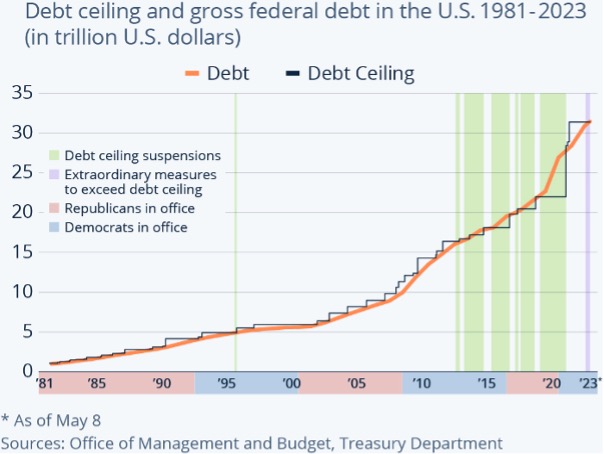In the realm of fiscal policy, the US debt ceiling is a crucial and often debated topic. It represents a legal limit imposed by Congress on the total amount of debt the US government can accumulate to finance its operations. This article aims to shed light on what the debt ceiling is, its importance, and the implications it holds for the US.
What is the Debt Ceiling?
The debt ceiling, also known as the debt limit, is a statutory cap on the amount of money that the US government can borrow to meet its financial obligations. Debt ceiling in the US works like a credit card, we can only spend within the limits set by the credit card provider. Similarly, US government cannot borrow beyond debt ceiling limit, unless it is raised. It is set by Congress and must be periodically raised if the government wishes to exceed the current limit. The current debt limit is $31.4 trillion. That limit was breached in January, but the Treasury Department used “extraordinary measures” to provide the government with more cash while it figured out what to do. However, history suggests debt ceiling has been raised every time the US borrowings reached to that level. Congress has always acted when called upon to raise the debt limit. Since 1960, Congress has acted 78 separate times to permanently raise, temporarily extend, or revise the definition of the debt limit – 49 times under Republican presidents and 29 times under Democratic presidents. Congressional leaders in both parties have recognized that this is necessary.

The importance of the Debt Ceiling
• Government solvency: The primary purpose of the debt ceiling is to ensure that the government operates within its means and maintains its solvency. It places a check on the government’s borrowing capacity, prompting lawmakers to review and approve additional borrowing when necessary.
• Fiscal responsibility: By imposing a debt ceiling, Congress aims to encourage responsible fiscal management. Lawmakers must weigh the potential consequences of excessive borrowing and make informed decisions regarding spending and revenue generation.
• Legislative oversight: The debt ceiling provides an opportunity for Congress to exercise its oversight function. It allows lawmakers to scrutinize and assess the government’s financial policies, spending priorities, and long-term budgetary implications.
• Market stability: The debt ceiling impacts financial markets and investor confidence. Failure to raise the debt ceiling in a timely manner could lead to uncertainty, higher borrowing costs, and a negative impact on the economy. The debt ceiling debate often sparks market volatility and can potentially undermine the faith in the US government’s creditworthiness.
Implications and challenges
• Government shutdown: If the debt ceiling is not raised in a timely manner and the government exhausts its available funds, it may result in a government shutdown. This scenario disrupts government operations, affects federal employees, and hampers critical services.
• Credit rating downgrade: Failure to raise the debt ceiling could lead to a credit rating downgrade, diminishing the perception of US government bonds as a safe investment. This downgrade would increase borrowing costs, potentially ripple through global markets, and undermine the country’s economic standing.
• Economic impact: The debt ceiling debate can create uncertainty, which in turn affects investor confidence and economic growth. Businesses may delay investments, consumers may become cautious, and financial markets may experience increased volatility.
Debt Ceiling debates and resolutions
Raising the debt ceiling has historically been a politically charged process, with debates often centring on fiscal responsibility, spending priorities, and partisan interests. These debates highlight the complex interplay between economic policy, politics, and the long-term financial health of the nation. To avoid the potentially severe consequences of not raising the debt ceiling, temporary measures such as “extraordinary measures” or short-term extensions are sometimes employed until a long-term solution is reached.
Over the past weeks, we have seen debates over raising the debt ceiling from all sides. Republicans had refused to raise the country’s borrowing limit unless Democrats agreed to cut spending, leading to a standoff that was not resolved until weeks of intense negotiations between the White House and House Speaker Kevin McCarthy. The final agreement, passed by the House on Wednesday, 31st May and the Senate on Thursday, 1st June suspends the debt limit until 2025 – after the next presidential election – and restricts government spending. It gives lawmakers budget targets for the next two years in hopes of assuring fiscal stability. On 3rd June, President Biden signed into law bipartisan legislation that suspends the $31.4 trillion debt ceiling, narrowly avoiding an unprecedented U.S. default that could have pushed the economy into a recession and financial crisis.
The US debt ceiling serves as a critical mechanism to regulate government borrowing, ensuring fiscal responsibility, and maintaining solvency. While it is a means to exercise oversight and control, the debt ceiling debate often raises concerns about economic stability and political gridlock. Efforts to raise the debt ceiling must strike a delicate balance between managing the country’s debt burden and providing the necessary resources for the government to fulfil its obligations. By navigating these challenges effectively, the US can maintain financial stability and preserve its position as a global economic powerhouse, at least for now, however, in the long run continuous increase in the US debt appears unsustainable as other economic powers like China emerge amongst other key factors. Therefore, one would expect the ability for the US to print dollars and increase its debt shall diminish.
To learn more about how we can help you, book a free initial consultation with one of our Financial Advisers.
Disclaimer
This article is for information only. Please do not act based on anything you might read in this article. Past performance is not a reliable indicator of current or future returns. This article contains general information only and does not consider individual objectives, taxation position or financial needs. Nor does this constitute a recommendation of the suitability of any investment strategy for a particular investor. It is not an offer to buy or sell or a solicitation of an offer to buy or sell any security or instrument or to participate in any trading strategy to any person in any jurisdiction in which such an offer or solicitation is not authorised or to any person to whom it would be unlawful to market such an offer or solicitation.
When you access a shared link of third-party websites, you are leaving our website and assume total responsibility and risk for your use of the third-party websites. We make no representation as to the completeness or accuracy of information provided at these websites nor do we endorse the content and information contained on those sites.

